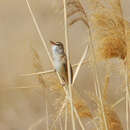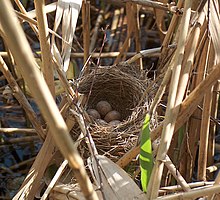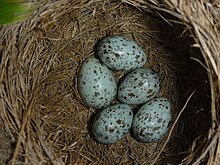fi
nimet breadcrumb-navigoinnissa


Males sing songs of two varieties, one for attraction of females and the other for defending their territory. The mate attraction song lasts around four seconds. The territorial defense call is about one second in length. With these short territorial defense calls they are able to warn off other males without interrupting their other calls.
Communication Channels: acoustic
Perception Channels: visual ; tactile ; acoustic ; chemical
Assessed in 2008, IUCN classifies great reed warblers as "least concern." The IUCN estimates a population size of 2,900,000 to 5,700,000 individuals.
US Migratory Bird Act: no special status
US Federal List: no special status
CITES: no special status
State of Michigan List: no special status
IUCN Red List of Threatened Species: least concern
There are no known adverse effects of great reed warblers on humans.
Great reed warblers are appreciated by bird enthusiasts for their songs and mimicry.
Great reed warblers impact their ecosystem by dispersing seeds and eating insects. Their nests are sometimes parasitized by common cuckoos (Cuculus canorus). They are susceptible to plasmodium infection.
Ecosystem Impact: disperses seeds; creates habitat
Commensal/Parasitic Species:
Great reed warblers have a varied, mainly carnivorous diet. They usually eat insects and spiders. Some fruits are eaten in the non-breeding season. They have also been observed eating snails, small fish, and frogs. Male warblers bring food to nesting females.
Animal Foods: amphibians; fish; insects; terrestrial non-insect arthropods; mollusks
Plant Foods: fruit
Primary Diet: carnivore (Insectivore , Eats non-insect arthropods)
Great reed warblers are migratory. Beginning in April and through the summer months, great reed warblers are found in northern Europe, especially the southern central region of Sweden. During the rest of the year, they migrate to the tropical regions of western Africa.
Biogeographic Regions: palearctic (Native ); ethiopian (Native )
Great reed warblers are typically found near water, swamps and streams, in reed beds and other vegetation.
Range elevation: 200 to 700 m.
Habitat Regions: temperate ; terrestrial
Terrestrial Biomes: savanna or grassland
Aquatic Biomes: lakes and ponds
Wetlands: marsh ; swamp
Other Habitat Features: riparian
Little information is available on the lifespan of great reed warblers. They may live an average of 2.4 years in the wild.
Average lifespan
Status: wild: 2.4 years.
Great reed warblers are one of the larger warblers with masses of 21 to 51 grams and a typical length of 20 centimeters. The wings are long and rather pointed at the end. They have a brown color above and a whiter shade on the underbelly.
Range mass: 21 to 51 g.
Range length: 19 to 20 cm.
Average wingspan: 26 cm.
Other Physical Features: endothermic ; homoiothermic; bilateral symmetry
Sexual Dimorphism: sexes alike
Great reed warblers emit alarm calls when they detect predators, such as marsh harriers. Bitterns and water rails are predators of eggs and nestlings. Other predators are not known. Great reed warblers are vigilant against predators and their cryptic coloration may help avoid predation.
Known Predators:
Anti-predator Adaptations: cryptic
Many male great reed warblers are monogamous and polygynous. Females choose their mate partially on the quality of their territory, males with high quality territories tend to be polygynous. Females tend to choose territories in accordance with food abundance and based on nest site quality. Attractive territories also have less risk of nest predation. Males with lower quality nesting territories are monogamous or fail to mate. Polygynous males provide less parental care. Males also warn females by giving alarm calls when predators approach.Females also choose mates based on their song repertoire, which predicts reproductive success. Hasselquist et al. (1996) noted that females copulate with males other than their first mate only when that male has a greater song repertoire, resulting in extra-pair copulations. By engaging in extra-pair copulation, females are seeking benefits for their offspring since the fledgling survival is positively related to the father's song repertoire size.
Mating System: monogamous ; polygynous
Great reed warblers breed from early April through August in northern Europe and during the winter in parts of Africa. An average of three to six eggs per season are laid. Nestlings hatch after 14 days of incubation. Great reed warblers mate in reed beds of marshes and lakes.
Breeding interval: Great reed warblers breed seasonally, number of clutches attempted per breeding season is not reported.
Breeding season: Breeding occurs from April to early August in Europe and in the winter in parts of Africa.
Range eggs per season: 3 to 6.
Average time to hatching: 14 days.
Average fledging age: 9 days.
Average time to independence: 2 weeks.
Key Reproductive Features: iteroparous ; seasonal breeding ; gonochoric/gonochoristic/dioecious (sexes separate); sexual ; oviparous
Females are responsible for building the nest and provide most of the parental care. The main contribution from the males is in protection of the nesting area from predators. Polygynous males help provide food for the offspring only for his first mate. Secondary mates must provide for their offspring on their own. Monogamous males provide food for the offspring.
Parental Investment: altricial ; pre-fertilization (Provisioning, Protecting: Female); pre-hatching/birth (Provisioning: Female, Protecting: Male, Female); pre-weaning/fledging (Provisioning: Male, Female, Protecting: Male, Female)
Regular passage visitor.
The great reed warbler (Acrocephalus arundinaceus) is a Eurasian in the passerine genus Acrocephalus.
The genus name Acrocephalus is from Ancient Greek akros, "highest", and kephale, "head". It is possible that Naumann and Naumann thought akros meant "sharp-pointed". The specific arundinaceus is from Latin and means "like a reed", from arundo, arundinis, "reed".[3]
It used to be placed in the Old World warbler assemblage, but is now recognized as part of the marsh and tree-warbler family (Acrocephalidae). Great reed warblers are medium-sized birds and are the largest of the European warblers. They breed throughout mainland Europe and the west Palearctic and migrate to sub-Saharan Africa in the winter. [4] Great reed warblers favour reed beds as their habitat during breeding months, while living in reed beds, bush thickets, rice fields, and forest clearings during the winter. Great reed warblers exhibit relatively low sexual dimorphism, and both genders of the species are similar in appearance. This species mates both polygynously and monogamously.
The thrush-sized warbler is one of the largest species of the former family, the Old World warblers and it stands as one of the largest species in the family Acrocephalidae. It measures 16–21 cm (6.3–8.3 in) in length, 25 to 30 cm (9.8 to 11.8 in) in wingspan and weighs 22 to 38 g (0.78 to 1.34 oz).[5][6][7] The adult has unstreaked brown upperparts and dull buffish-white chin and underparts. The forehead is flattened, and the bill is strong and pointed. It looks very much like a giant Eurasian reed warbler (A. scirpaceus), but with a stronger supercilium.
The sexes are identical, as with most old world warblers, but young birds are richer buff below.
The warbler's song is very loud and far-carrying. The song's main phrase is a chattering and creaking carr-carr-cree-cree-cree-jet-jet, to which the whistles and vocal mimicry typical of marsh warblers are added.

The great reed warbler breeds in Europe and the west Palearctic. It does not breed in Great Britain, but is an irregular visitor. Its population has in recent decades increased around the eastern Baltic Sea, while it has become rarer at the western end of its range. It is a migratory bird, wintering in tropical Africa. This bird migrates north at a rather late date, and some birds remain in their winter quarters until the end of April.[1][8][9]
While there are no subspecies of this bird, mtDNA haplotype data indicate that during the last glacial period there were two allopatric populations of great reed warbler. The great reed warblers in southwestern and southeastern Europe were at that time apparently separated by the Vistulian-Würm ice sheets and the surrounding barren lands. Though the data are insufficient to robustly infer a date for this separation, it suggests the populations became separated around 80,000 years ago – coincident with the first major advance of the ice sheets. The populations must have expanded their range again at the start of the Holocene about 13,000 years ago, but even today the western birds winter in the west and the eastern birds in the east of tropical Africa.[9]
During 2017--2019, miniature data loggers were used to track migratory flights of great reed warblers, over the Mediterranean Sea and Sahara Desert, between their breeding grounds at Lake Kvismaren, Sweden, and their winter quarters in sub-Saharan Africa.[4] When over the Sahara Desert, some birds would ascend to altitudes exceeding 5 km. As of 2023, these are the highest recorded avian ascents. [10] For comparison, such altitudes are comparable to those of the summits of the highest mountains in Africa and Europe. Possible explanations for such high--altitude ascents include avoidance of predation, reduction of risk of hyperthermia and dehydration, and extension of the visual horizon.[4][10]
This passerine bird is found in large reed beds, often with some bushes. On their breeding grounds, they are territorial. In their winter quarters, they are frequently found in large groups, and may occupy a reed bed to the exclusion of other birds.[8] Like most warblers, it is insectivorous, but it will take other prey items of small size, including vertebrates such as tadpoles.
The great reed warbler undergoes marked long-term population fluctuations, and it is able to expand its range quickly when new habitat becomes available. This common and widespread bird is considered a species of least concern by the IUCN.[1][9] Population size can be calculated with a suitability model, but direct counts of territorial males in suitable habitat and sampling the population sex-ratio can be a proper alternative to inference-rich predictive modeling based on imperfect habitat-extrapolation of densities of reed warblers at large spatial scales.[11]
A. arundinaceus has a primarily carnivorous diet. Observation of prey collection specifically during breeding season has shown the retrieval of insect larvae, moths, dragonflies, damselflies, beetles, spiders, small fish, and frogs.[14] A. arundinaceus has also been reported to eat fruit during non-breeding seasons.[15] Nestlings typically feed on diptera and arachnids, though this may not be their preferred food.[16]
Male great reed warblers have been observed to communicate via two basic song types: short songs about one second in length with few syllables, and long songs of about four seconds that have more syllables and are louder than the short variety. It has been observed that long songs are primarily used by males to attract females; long songs are only given spontaneously by unpaired males, and cease with the arrival of a female. Short songs, however, are primarily used in territorial encounters with rival males.[17]
During experimental observation, male great reed warblers showed reluctance to approach recordings of short songs, and when lured in by long songs, would retreat when playback was switched to short songs.[17]
Traditionally, monogamous species of genus Acrocephalus use long, variable, and complex songs to attract mates, whereas polygynous varieties use short, simple, stereotypical songs for territorial defence. There is evidence that long songs have been evolved through intersexual selection, whereas short songs have been evolved through intrasexual selection. The great reed warbler is a notable example of these selective pressures, as it is a partial polygynist and has evolved variable song structure (both long and short) through evolutionary compromise.[17]
In addition to communication, the great reed warbler's song size has been implicated in organism fitness and reproductive success. Though no direct relationship has been found between song size and either territory size or beneficial male qualities, such as wing length, weight, or age, strong correlation has been observed between repertoire size and territory quality. Furthermore, partial correlation analysis has shown that territory quality has significant effect on the number of females obtained, while repertoire length is linked to the number of young produced.[18]

Great reed warbler females lay 3–6 eggs in an open cup-nest in reeds. Some pairs of warblers are monogamous, but others are not, and unpaired, so-called "satellite" males still father some young.[19] Great reed warblers defend their nests using graded alarm calls, directed towards a wide range of enemies,[20] although these alarm calls might reveal the whereabouts of the nest to brood parasites.[21]
A long-term study of the factors that contribute to male fitness examined the characteristics of males and territories in relation to annual and lifetime breeding success. It showed that the arrival order of the male was the most significant factor for predicting pairing success, fledgling success, and number of offspring that survive. It also found that arrival order was closely correlated with territory attractiveness rank. Females seem to prefer early arriving males that occupy more attractive territories. These females also tend to gain direct benefits through the increased production of fledglings and offspring that become adults. In addition, male song repertoire length is positively correlated to annual harem size and overall lifetime production of offspring that survive. Song repertoire size alone is able to predict male lifetime number of surviving offspring. Females tend to be attracted to males with longer song repertoires since they tend to sire offspring with improved viability. In doing so, they gain indirect benefits for their own young.[22][23]
Great reed warblers have a short, polygynous breeding cycle in which the male contributes little to parental care. They defend large territories in reed beds where there is reduced visibility, which may allow males to practice deception by moving and attracting a second female. This second female may not realize that the male has already mated. Polygyny of the great reed warbler was assessed in another study that showed the importance of female choice. The differences in territory characteristics seemed to be more important. However, there is also a strong correlation between males and their territory characteristics. Models based on the polygyny threshold and sexy son hypotheses predict that females should gain evolutionary advantage in either short-term or long-term in this mating system, yet the study did not support this. The data showed that secondary females had greatly reduced breeding success.[24][25]
The great reed warbler (Acrocephalus arundinaceus) is a Eurasian in the passerine genus Acrocephalus.
The genus name Acrocephalus is from Ancient Greek akros, "highest", and kephale, "head". It is possible that Naumann and Naumann thought akros meant "sharp-pointed". The specific arundinaceus is from Latin and means "like a reed", from arundo, arundinis, "reed".
It used to be placed in the Old World warbler assemblage, but is now recognized as part of the marsh and tree-warbler family (Acrocephalidae). Great reed warblers are medium-sized birds and are the largest of the European warblers. They breed throughout mainland Europe and the west Palearctic and migrate to sub-Saharan Africa in the winter. Great reed warblers favour reed beds as their habitat during breeding months, while living in reed beds, bush thickets, rice fields, and forest clearings during the winter. Great reed warblers exhibit relatively low sexual dimorphism, and both genders of the species are similar in appearance. This species mates both polygynously and monogamously.